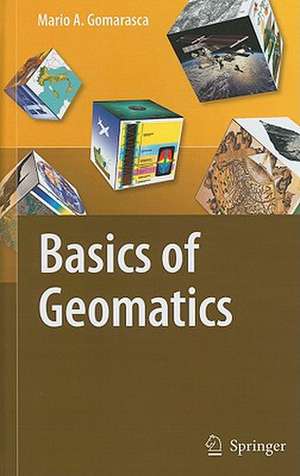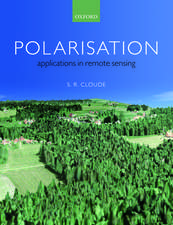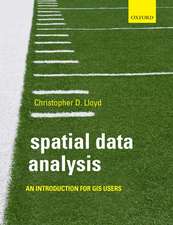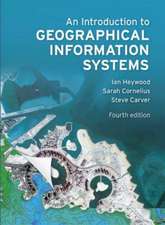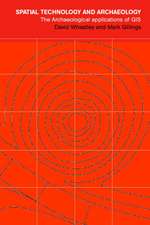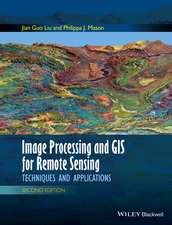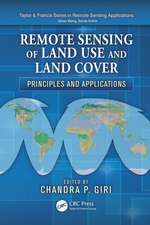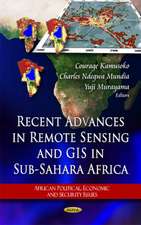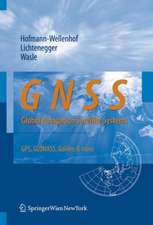Basics of Geomatics
Autor Mario A. Gomarascaen Limba Engleză Hardback – 14 oct 2009
| Toate formatele și edițiile | Preț | Express |
|---|---|---|
| Paperback (1) | 1399.11 lei 43-57 zile | |
| SPRINGER NETHERLANDS – 28 noi 2014 | 1399.11 lei 43-57 zile | |
| Hardback (1) | 1404.30 lei 43-57 zile | |
| SPRINGER NETHERLANDS – 14 oct 2009 | 1404.30 lei 43-57 zile |
Preț: 1404.30 lei
Preț vechi: 1712.56 lei
-18% Nou
Puncte Express: 2106
Preț estimativ în valută:
268.71€ • 281.31$ • 222.34£
268.71€ • 281.31$ • 222.34£
Carte tipărită la comandă
Livrare economică 07-21 aprilie
Preluare comenzi: 021 569.72.76
Specificații
ISBN-13: 9781402090134
ISBN-10: 1402090137
Pagini: 700
Ilustrații: XLI, 656 p.
Dimensiuni: 155 x 235 x 48 mm
Greutate: 1.11 kg
Ediția:2009
Editura: SPRINGER NETHERLANDS
Colecția Springer
Locul publicării:Dordrecht, Netherlands
ISBN-10: 1402090137
Pagini: 700
Ilustrații: XLI, 656 p.
Dimensiuni: 155 x 235 x 48 mm
Greutate: 1.11 kg
Ediția:2009
Editura: SPRINGER NETHERLANDS
Colecția Springer
Locul publicării:Dordrecht, Netherlands
Public țintă
ResearchCuprins
Geomatics.- Elements of Cartography.- Elements of Photogrammetry.- Elements of Remote Sensing.- Elements of Informatics.- Acquisition Systems.- Satellite Positioning Systems.- Digital Image Processing.- Elements of Geographical Information Systems.- Land Use/Land Cover Classification Systems.
Recenzii
From the reviews:
"The book is rigorous and synthetic, describing with precision the main instruments and methods connected to the multiple techniques today available. The objective pursued is to publish an integrated text, containing simple and comprehensible concepts relevant to experts in Geo-spatial Information."
S. Dequal, Professor of Topography and Photogrammetry, DITAG, Polytechnic of Turin, Italy
"This book fills a void of telling and showing the reader how remote sensing as a part of geomatics really works. With a clearly presented historical review up to the present time, the author illustrates the basic theories and use of the different remote sensing sensors and how to analyze the data from them for their application. The author has had many years of experience in the analysis of remote sensing data and one can feel the confidence that he has as in presenting the material. This book would be a complement to the standard remote sensing books and I would highly recommend it for all land oriented professionals and especially graduate students who need a clear explanation of how remote sensing works. For anyone who uses remote sensing data as related to land analysis and survey, this book should be part of their library."
Chris J. Johannsen, Professor Emeritus of Agronomy, Department of Agronomy,
Purdue University, West Lafayette, Indiana, USA
"Basics of Geomatics is structured in a clear and effective way into
thematic chapters that provide a fundamental, yet comprehensive coverage
of each of the major disciplines making up the field of Geomatics.
Thanks to its clarity and completeness, the text, supplemented by many
useful tables and illustrations will serve as a basic reference work for
both beginners and experienced readers."
J.L.van Genderen, ITC, Enschede, The Netherlands
“This work, translated from Italian, is unique in that itaddresses a particular gap in the remote sensing literature … aimed at a broader group of readers who may be using geospatial information in their work. … The text is supported with numerous illustrations and well-explicated formula. … color plates are included at the end of the volume. The comprehensive index greatly contributes to this book’s effectiveness as a reference tool for both students and professionals. Summing Up: Recommended. Upper-division undergraduate through professional collections.” (W. Weston, Choice, Vol. 47 (11), August, 2010)
"The book is rigorous and synthetic, describing with precision the main instruments and methods connected to the multiple techniques today available. The objective pursued is to publish an integrated text, containing simple and comprehensible concepts relevant to experts in Geo-spatial Information."
S. Dequal, Professor of Topography and Photogrammetry, DITAG, Polytechnic of Turin, Italy
"This book fills a void of telling and showing the reader how remote sensing as a part of geomatics really works. With a clearly presented historical review up to the present time, the author illustrates the basic theories and use of the different remote sensing sensors and how to analyze the data from them for their application. The author has had many years of experience in the analysis of remote sensing data and one can feel the confidence that he has as in presenting the material. This book would be a complement to the standard remote sensing books and I would highly recommend it for all land oriented professionals and especially graduate students who need a clear explanation of how remote sensing works. For anyone who uses remote sensing data as related to land analysis and survey, this book should be part of their library."
Chris J. Johannsen, Professor Emeritus of Agronomy, Department of Agronomy,
Purdue University, West Lafayette, Indiana, USA
"Basics of Geomatics is structured in a clear and effective way into
thematic chapters that provide a fundamental, yet comprehensive coverage
of each of the major disciplines making up the field of Geomatics.
Thanks to its clarity and completeness, the text, supplemented by many
useful tables and illustrations will serve as a basic reference work for
both beginners and experienced readers."
J.L.van Genderen, ITC, Enschede, The Netherlands
“This work, translated from Italian, is unique in that itaddresses a particular gap in the remote sensing literature … aimed at a broader group of readers who may be using geospatial information in their work. … The text is supported with numerous illustrations and well-explicated formula. … color plates are included at the end of the volume. The comprehensive index greatly contributes to this book’s effectiveness as a reference tool for both students and professionals. Summing Up: Recommended. Upper-division undergraduate through professional collections.” (W. Weston, Choice, Vol. 47 (11), August, 2010)
Textul de pe ultima copertă
This volume presents a comprehensive and complete treatment. In a systematic way the complex topics and techniques are covered that can be assembled under Geospatial Information namely, Geodesy, Cartography, Photogrammetry, Remote Sensing, Informatics, Acquisition Systems, Global Positioning Systems, Digital Image Processing, Geographic Information Systems, Decision Support Systems, and WebGIS. It describes in detail and at an accessible level - too much math has been avoided - the state of current knowledge. Per chapter a detailed bibliography has been included.
As such, it will serve as a working tool not only to geoscientists and geographers but also to engineers, architects, computer scientists, urban planners, specialists in GIS, remote sensing, forestry, agricultural science, soil science geometry, environmental scientists and managers.
Applications can be found in security, risk management, monitoring, info-mobility, geo-positioning, food traceability, etc.
From the reviews:
"The book is rigorous and synthetic, describing with precision the main instruments and methods connected to the multiple techniques today available. The objective pursued is to publish an integrated text, containing simple and comprehensible concepts relevant to experts in Geo-spatial Information."
S. Dequal, Professor of Topography and Photogrammetry, DITAG, Polytechnic of Turin, Italy
"This book fills a void of telling and showing the reader how remote sensing as a part of geomatics really works. With a clearly presented historical review up to the present time, the author illustrates the basic theories and use of the different remote sensing sensors and how to analyze the data from them for their application. This book would be a complement to the standard remote sensing books and I would highly recommend it for all land oriented professionals and especially graduate students who need a clear explanation of how remote sensing works".
Chris J. Johannsen, Professor Emeritus of Agronomy, Department of Agronomy, Purdue University, West Lafayette, Indiana, USA
"Basics of Geomatics" is structured in a clear and effective way into thematic chapters that provide a fundamental, yet comprehensive coverage of each of the major disciplines making up the field of Geomatics. Thanks to its clarity and completeness, the text, supplemented by many useful tables and illustrations will serve as a basic reference work for both beginners and experienced readers".
John L. van Genderen, Professor, International Institute for Geoinformation Science and Earth Observation (ITC), Department of Earth Observation Science, Enschede, The Netherlands.
As such, it will serve as a working tool not only to geoscientists and geographers but also to engineers, architects, computer scientists, urban planners, specialists in GIS, remote sensing, forestry, agricultural science, soil science geometry, environmental scientists and managers.
Applications can be found in security, risk management, monitoring, info-mobility, geo-positioning, food traceability, etc.
From the reviews:
"The book is rigorous and synthetic, describing with precision the main instruments and methods connected to the multiple techniques today available. The objective pursued is to publish an integrated text, containing simple and comprehensible concepts relevant to experts in Geo-spatial Information."
S. Dequal, Professor of Topography and Photogrammetry, DITAG, Polytechnic of Turin, Italy
"This book fills a void of telling and showing the reader how remote sensing as a part of geomatics really works. With a clearly presented historical review up to the present time, the author illustrates the basic theories and use of the different remote sensing sensors and how to analyze the data from them for their application. This book would be a complement to the standard remote sensing books and I would highly recommend it for all land oriented professionals and especially graduate students who need a clear explanation of how remote sensing works".
Chris J. Johannsen, Professor Emeritus of Agronomy, Department of Agronomy, Purdue University, West Lafayette, Indiana, USA
"Basics of Geomatics" is structured in a clear and effective way into thematic chapters that provide a fundamental, yet comprehensive coverage of each of the major disciplines making up the field of Geomatics. Thanks to its clarity and completeness, the text, supplemented by many useful tables and illustrations will serve as a basic reference work for both beginners and experienced readers".
John L. van Genderen, Professor, International Institute for Geoinformation Science and Earth Observation (ITC), Department of Earth Observation Science, Enschede, The Netherlands.
Caracteristici
Presents a comprehensive and complete treatment Covers in an easy accessible manner the complex topics and techniques covered under geomatics Abundantly illustrated Defined as the "Bible of Geomatics" in Italy
